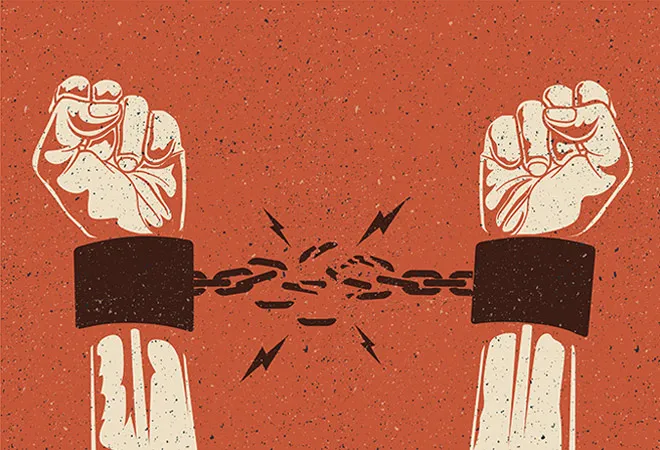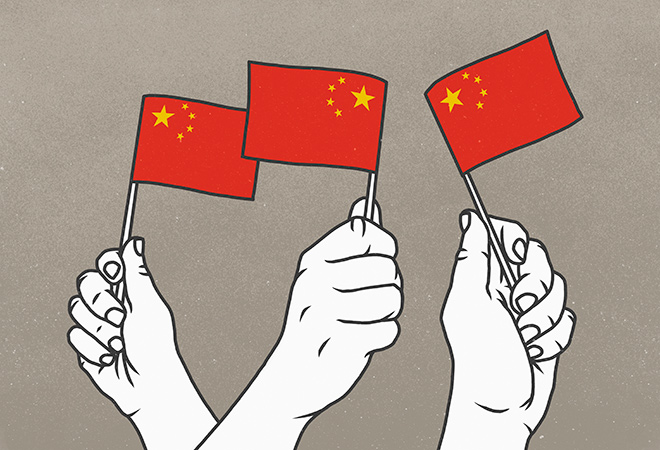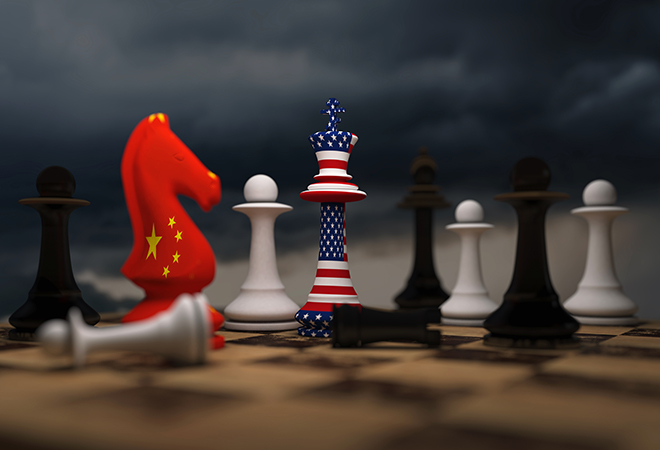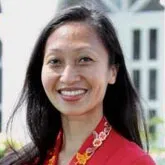-
CENTRES
Progammes & Centres
Location
Tensions between government and industry over encryption, vulnerabilities and privacy are now compounded by a geo-technological rupture between the world’s two largest powers.

In the 1990s, globalisation and digitisation promised to bring the world closer together through trade, travel and technology. The end of the Cold War and the advent of the internet offered a vision of a more interdependent future in which the increased flows of people, investment and supply chains across borders was expected to bring the world greater peace, predictability and prosperity. Instead, the last decade has exposed just what a tangled web we have woven.
Noisy dial-up modems may have long given way to evolving generations of wireless communications. However, innovation has not necessarily resulted in greater trust or integrity of operations or political relations. Tensions between government and industry over encryption, vulnerabilities and privacy are now compounded by a geo-technological rupture between the world’s two largest powers. Mounting mistrust between the US and China threatens to upend global supply chains, alienate large parts of the world and complicate international cooperation.
Innovation has not necessarily resulted in greater trust or integrity of operations or political relations.
This paper explores the implications of the US-China political rift in the digital sphere, particularly from the perspective of the Global South. In the first part, this paper sketches the reality and risks of digital interdependence. The second part takes a step back by examining the geography and demography of the digital world and asks whether that interdependence is not actual dependence of one part of the world upon another. Who would be most impacted by a geo-technological schism in the long run? Who should technology ultimately serve? The final part of this paper offers some ways ahead for countries in the Global South to eschew the path dominated by the US-China rivalry and to forge their own digital future(s) underpinned by inclusivity, cooperation and stability.
The declaration of “the age of digital interdependence” in the 2019 report of the UN Secretary-General’s High-Level Panel on Digital Cooperation is as much reflective of present-day realities as it is aspirational. Recognising that “digital dividends co-exist with digital divides,” the report underscores the urgency of an inclusive digital future through improved digital cooperation. <1> In launching the Roadmap for Digital Cooperation <2>, which itself builds upon the work of the High-Level Panel, UN Secretary-General Antonio Guterres remarked that, “We are at a critical point for technology governance.. If we do not come together now around using digital technology for good, we will lose a significant opportunity to manage its impact, and we could see further fragmentation of the internet, to the detriment of all.” <3>
About one-third of Huawei’s core suppliers are American, with the rest coming from within China, Japan and certain countries in Europe.
At the manufacturing level, the story of technological interdependence is a familiar one enabled by comparatively advantageous resource and labour markets as well as the efficiency of international logistics supply chains. It is often pithily captioned as, “Designed in the USA, Assembled in China,” even though the supply chains of technology titans nearly half the world. Intel’s first tier of direct suppliers alone numbers more than 10,000 in 89 countries. <4> Apple’s top 200 suppliers across Asia, Europe and the Americas represent 98 percent of the company’s procurement expenditures. <5> The rise of Chinese mobile smartphone vendors such as Xiaomi and Oppo in the global marketplace has further deepened the interdependence of parts and people in the global supply and value chains. About one-third of Huawei’s core suppliers are American, with the rest coming from within China, Japan and certain countries in Europe. By virtue of their specialisation, companies that supply chips to Huawei and Xiaomi also supply to Apple and Samsung. <6>
The mobile device marketplace is a microcosm of technological interdependence in the world. As enterprises seek to leverage the digital economy and governments formulate policies around a Fourth Industrial Revolution, faster connection speeds and low network latency will be key. Yet, the promise of both these advances through fifth generation (5G) wireless technology has become fraught with difficult choices. The threat of compromise to a nation’s security through 5G installations looms large. The risk calculations, however, vary by country on account of commercial calculations, historical experiences and political-security relations. For example, the UK’s July 2020 decision to exclude Huawei from its 5G networks following US restrictions on the Chinese company will require uprooting Huawei legacy infrastructure. As a result, 5G deployment in the UK will be deferred by about three years with financial costs amounting to £7 billion. <7> This amount may be negligible for an economy the size of the UK, particularly when spread out over a number of years. However, developing countries seeking an economic springboard through technology may be less willing or equipped to bear that delay.
The promise of both these advances through fifth generation (5G) wireless technology has become fraught with difficult choices.
Further, for most countries, China is not an adversary even if its rise generates some anxiety. Thus, while the remaining four of the Five Eyes countries — Australia, Canada, New Zealand, the UK, who have formed an intelligence alliance with the US — have aligned their 5G decisions more closely with the US’s position on Chinese companies, countries elsewhere — even US treaty allies — have varied in their deliberations. Thailand, the US’s oldest treaty ally in Asia, has refrained from ruling out Chinese suppliers in its 5G plans but indicated that it would remain mindful of security concerns. <8> This approach is similar to that of numerous other countries, including the Philippines, another US treaty ally in Southeast Asia. <9> In Latin America, where the socio-economic benefits of the digital revolution are beginning to be felt, countries are keen to avoid a trade war, fragmentation of the internet and the morphing of cyberspace into the next military domain. <10>
 For most countries, China is not an adversary even if its rise generates some anxiety. Illustration: Malte Mueller/Getty
For most countries, China is not an adversary even if its rise generates some anxiety. Illustration: Malte Mueller/Getty
Developing countries with limited resources face tough choices. As these states build upon their infrastructural and digitalisation plans by partnering with China, Japan, South Korea, the European Union and the US’ private sectors, governments will find it more and more difficult to extricate themselves from the fabric of critical infrastructure interdependence. Some of this enmeshment will be coincidental and some of it will be deliberate for risk diversification purposes. For the ASEAN region actively seeking to boost intra-regional connectivity through initiatives such as the ASEAN Smart Cities Network, a patchwork of providers underwriting the security of countries’ critical infrastructure across borders may be sub-optimal in the long run. Harmonising technological connectivity across ten member states, preserving infrastructural or platform interoperability, while respecting states’ sovereign decisions to choose their own networks and vendors may prove tricky if worsening US-China relations spill over into the region. But the flipside of a vendor mélange — single-source reliance — is also risky.
Indigenous capability, while ideal, remains a long-term goal.
Considerations of a zero-trust network that have begun to shadow the cybersecurity mantra of “trust but verify” may well have to apply to the larger security and strategic considerations of states. <1> Vietnam and India, for example, have embarked on building their own indigenous 5G ecosystems involving local vendors despite the countries’ large rural populations and high capital outlay of 5G infrastructure. <11> The prohibitively high costs do not generally make homegrown solutions a practical alternative for smaller states. And indigenous capability, while ideal, remains a long-term goal.
Interdependence, then, may still be the only viable preference. However, interdependence glosses over asymmetrical geopolitical realities in many parts of the world.
The grand promise of digitalisation is to improve and uplift the lives of people. In parts of Sub-Saharan Africa, Asia, Latin America and the Caribbean, which are experiencing a rise in working age population, digitalisation can magnify the economic potential of this demographic dividend with the appropriate technological tools, government policies and private sector investment. Indeed, there has been encouraging progress in many parts of the Global South. Technology applications have assisted Ethiopian farmers with weather forecasts, the mapping of Ebola incidences and response in Sierra Leone, the growth of e-commerce across Asia, and managing urbanisation in Brazil. <12>
The lowest mobile phone (not necessarily smartphone) ownership rates are still found in South Asia and Africa because ownership is correlated to income levels.
As of last year, an estimated 4.1 billion people were using the Internet, just over half the world’s population. The relative affordability and availability of mobile connections and devices means that in all regions of the world, Internet access is facilitated through devices other than the computer. <13> Today, there are an estimated five billion smartphone connections in the world, with Samsung, Huawei and Apple devices dominating the market. That number is expected to rise to seven billion connections by 2025, with nearly two-thirds of new subscribers coming from the Asia Pacific and Sub-Saharan Africa. <14> The digital future, therefore, looks set to be mobile.
Yet, despite this projection, the lowest mobile phone (not necessarily smartphone) ownership rates are still found in South Asia and Africa because ownership is correlated to income levels. These rates mirror the vastly uneven distribution of Internet access in the world, with most of the offline population living in least developed countries, primarily in Africa and South Asia. Additionally, mobile broadband bundle packages, including voice and data, are relatively more costly in Africa. <15>
It seems only fair to expect the governance structures — the norms, rules and international legal frameworks — of technology to reflect the perspectives, expectations and value-systems of the world’s majority.
This digital divide is even more starkly pronounced when compared against the demographics of the world. Today, 61 percent of the world’s population lives in Asia. <16> Much of that figure is presently accounted for by the populations of China and India, but a majority (seven) of the 13 countries with over 100 million in population are also in Asia. <17> By the turn of the century, 90 percent of the world’s population is expected to live outside Europe and North America, with most in Asia and Sub-Saharan Africa. <18>
 A Ugandan factory worker assembles a mobile phone mother board in Namanve, Kampala — December 2019. © Luke Dray/Getty
A Ugandan factory worker assembles a mobile phone mother board in Namanve, Kampala — December 2019. © Luke Dray/Getty
If most of the world’s population lives in the Global South and represents the fastest growing markets for digital products and services, then surely these constituencies should have proportionate access to technology? They should also have an equivalent say in how technology should and will change their lives. Correspondingly, it seems only fair to expect the governance structures — the norms, rules and international legal frameworks — of technology to reflect the perspectives, expectations and value-systems of the world’s majority. Nothing could be further from the truth right now.
There are two related issues to unpack. The first concerns the consumption of technology as well as data generation in the Global South. The second involves the international governance structures regulating how technology and data should be used as well as who gets to set those rules.
The transformational value of data for social good only emerges when it can serve the diverse and often underrepresented sources from whom it is mined.
Apart from China and India, much of the Global South consists largely of users rather than producers of technology at scale. The size and population density of countries in the Global South along with increasing mobile penetration rates, therefore, present remarkable opportunities for big data collection and algorithmic processing. This data can be a force for good. But the transformational value of data for social good only emerges when it can serve the diverse and often underrepresented sources from whom it is mined. <19> The loss of agency of individual users upon surrender of their data coupled with the powerful role of Big Tech trigger the concern of “private corporate actors exerting inordinate influence over national development policymaking and efforts.” <20>
US-based multinational companies (MNCs) such as Microsoft and Cisco, for example, have had a decades-long presence in the developing world. <21> These corporations and their products have nurtured much digital capacity and created thousands of jobs over the years but “MNCs do not create interdependent relations between local labour and global revenues that form around natural resource extraction.” <22> They have also not been without their own surveillance controversies, as the 2013 US National Security Agency leaks strikingly laid bare. <2> Additionally, the growth of social media goliaths such as Google and Facebook that have catalysed not only a whole new industry of data extraction but “a global architecture of behaviour modification” has provoked accusations of a new form of colonialism. <23> According to July 2020 data by Statista, Facebook alone draws nine of its top ten largest markets from the Global South. India tops that list at 290 million users. <24>
Like the Western firms that came before them, Chinese corporate — state-owned and otherwise — presence now s the domains of space, cyberspace, land and sea.
Michael Kwet argues that the domination of this digital architecture at the software, hardware, and network levels has reinvented colonialism in five ways: (1) resource extraction through rent and surveillance; (2) control of the digital ecosystem and thus control of the computer-mediated political, economic, and cultural domains of life; (3) the violation of privacy and concentration of economic power through big data into the hands of these US corporations; (4) private sector collusion with intelligence agencies to conduct mass and targeted surveillance in the Global South; and (5) US elite persuasion that the global society should accede to America’s own conceptions of the digital world, setting the basis for technological hegemony. <25>
These concerns persist and are heightened by the entry of newer corporate players, primarily from China, into the Global South. Le Monde’s investigative report of Chinese espionage of the African Union’s headquarters is but one example. <26> Suspicions have also been raised given the expansive reach of Chinese conglomerates as part of the Belt and Road Initiative (BRI). Like the Western firms that came before them, Chinese corporate — state-owned and otherwise — presence now s the domains of space (navigation satellite system), cyberspace (network, hardware and software applications), land (railroads, ports, and highways) and sea (international submarine communication cables).
China’s infrastructural investment across the globe largely through the BRI have raised unease that the economic and developmental aspects of the strategy may be weaponised through a relationship of dependence cast as one of interdependence.
The Chinese domestic market is large enough to fuel China’s artificial intelligence (AI) ambitions to be a global leader by 2030. The combination of state-driven policies and local industry innovation have backed China’s AI forays into everything from applications, such as healthcare and e-commerce, to the more ominous tools of behavioural surveillance and repression. Ongoing big data collaborative projects with external parties such as the China-ASEAN Digital Trade Center, China-ASEAN Information Harbour, and an e-commerce platform between China and West Asia/the Middle East will provide China further dual-use opportunities for data mining and algorithmic refinement. For example, data sent from Zimbabwe back to Cloudwalk Technology, a Chinese company contracted to undertake a mass facial recognition project for the African nation, will train the company’s algorithms to identity people of colour. <27> The supply of Chinese surveillance technology to several other African states, including Angola, Cape Verde, South Africa and Uganda, complete with training and infrastructure, stirs considerable apprehension of abuse. <28> However, there is cause for greater worry. Of note, China’s infrastructural investment in ports, railroads, highways, communication cables, cloud storage and digital platforms across the globe largely through the BRI have raised unease that the economic and developmental aspects of the strategy may be weaponised through a relationship of dependence cast as one of interdependence. <29>
China’s rise and, with it, the spectre of serious competition in a technological race long dominated by the US, has raised the stakes for governance of the digital space. Technical standards-setting, traditionally led by the European and American players, is emerging as a new front of competition as China’s drive for domestic standardisation of technology finds an international foothold through the incorporation of its standards into BRI projects as well as in its interest in the institutions of global standards. <30> Chinese leadership in and of standards-setting bodies such as the Third Generation Partner Project and the International Telecommunication Union help ensure China’s guidance of technical standards development. <31> Meanwhile, China’s participation in the United Nations Group of Governmental Experts (GGE) on Developments in the field of information and telecommunications in the context of international security and its most recent proposal of a global data security initiative, partially in response to the United States’ Clean Network Initiative, demonstrate active strides in international security agenda-setting in cyberspace. <32>
Technical standards-setting, traditionally led by the European and American players, is emerging as a new front of competition.
In its international proposals, China’s rhetoric of multilateralism rather than unilateralism, cooperation rather than exclusivism, and sovereignty rather than imperialism often resonates with many post-colonial nations in the Global South that are still grappling with the influence and overreach of the Global North. For these countries, a digital future should not witness the substitution of one hegemon for another nor should it play out as a tussle for patronage between empires. Equally, unlike the present, the diversity of the world’s largest populations in Asia and Africa — to paraphrase the Netflix documentary The Social Dilemma — should definitely no longer be underwritten by a bunch of white males in California.
A digital future for countries, independent of exploitation by government or private actors, may not always be completely possible given inequities in size, capacity, political power and technological capability. Another challenge will be to minimise dependence while preserving infrastructural or platform interoperability as Western and other technology players offer full-suite infrastructure, software, and data analysis packages.
 The politicisation of technology will continue to shroud developments taking shape like AI, quantum computing, and even sixth generation wireless networks. Illustration: Zhangshuang/Getty
The politicisation of technology will continue to shroud developments taking shape like AI, quantum computing, and even sixth generation wireless networks. Illustration: Zhangshuang/Getty
The recommendations below propose three approaches for a more informed, autonomous, meaningfully cooperative way ahead against the backdrop of an evolving geopolitical landscape.
First, at the international level, it is crucial for countries of the Global South to be a part of unfolding conversations on technology, regardless of whether they are technology innovators or not. All states, large and small, have a stake in a global digital future to which they belong, and are therefore entitled and in fact obligated to help shape it. Given the world’s population trends, Asian and African states should continue contributing to discussions by proactively initiating ideas or responding to existing ones drawing from their own unique contexts. Despite the geo-political undertones of their conception, the most current iteration of the GGE and its parallel process, the Open-Ended Working Group on Developments (OEWG) in the field of information and telecommunications, in the context of international security, have been valuable in raising issues awareness, broadening outlooks, and representing diversity of participation. <33>
The OEWG has provided a platform for more voices to be heard and exchanges to be had among groups of stakeholders that would not otherwise be in the same room. This was demonstrated most clearly during the OEWG’s informal consultation session in December 2019. <34> For countries not yet represented in the GGE, the OEWG has offered a chance for these states to register their interest and positions on important issues such as the application of international law in cyberspace. Given widespread interest among states in the representational aspect of the OEWG, it seems likely that calls for the continuation of the OEWG process will be supported. <35>
Second, for states to take full advantage of these UN and other international processes as well as of offers of capacity-building, they must be clear about their own priorities and interests. Discussions are most productive when they are informed and inclusive. Exchanges that take place regularly among government, industry and civil society at the domestic level can feed into more constructive and consequential conversations between the producers and innovators of technology on the one hand, and the users or consumers of technology on the other. They also build the foundation for greater self-determination of technology-related approaches and directions that countries may not else feel empowered to take at the regional and global levels.
Third, partnerships below the political level are most meaningful with open communication channels and a mutual willingness to collaborate. Partnerships that cut across backgrounds, such as the Partnership on Artificial Intelligence — a largely American grouping that includes think-tanks, civil society, academia, international organisations and even the Chinese tech giant Baidu — demonstrates the value of bridging geo-technological fault lines. Even in the absence of interdependence, there can still be cooperation.
US-China technological enmity is not preordained, and countries may not have to choose between the two powers. Ang Yuen Yuen argues that while China “excels in applying technology to improve business models — for example, in e-commerce and fintech — the US remains the unparalleled world leader in basic scientific research, the foundation of advanced technologies.” <36> China’s and the US’s technological comparative advantages may be different but not zero-sum. With some political will, their differences could even be complementary. With some optimism, there could even be a détente in this superpower split which would relieve pressures for the rest of the international community.
Hope, however, is not a strategy. Tensions will continue to rise as technology increasingly becomes a key determinant of national power. The politicisation of technology will continue to shroud developments taking shape like AI, quantum computing, and even sixth generation wireless networks. Correspondingly, market access and dominance, as well as technical standards-setting will emerge as greater points of competition.
For most of the world’s population in the still-developing countries of the Global South, agency, representation and clear-eyed choices will be key to autonomy in a future full of binaries. While technological interdependence may have been disrupted and independence may neither be desirable nor achievable, the phenomenon of developing world dependence on any one power should still be very much avoided. The premise for inclusivity, transparency and accountability in technology could not be more important. In coda we trust, all else is politics.
<1> United Nations, The Age of Digital Interdependence, Report of the United Nations Secretary-General High-Level Panel on Digital Cooperation, June 2019.
<2> “The Age of Digital Interdependence, June 2019”
<3> Antonio Guterres, “Secretary-General's remarks to the Virtual High-Level Event on the State of the Digital World and Implementation of the Roadmap for Digital Cooperation,” (speech, New York, June 11, 2020), United Nations.
<4> Intel, 2019-2020 Report: Corporate Responsibility at Intel, May 14, 2020, p. 46.
<5> Apple, “Supplier List,” Supplier Responsibility List 2019.
<6> John H. Junior, “Huawei says it has two suppliers for each component used in its products,” HuaweiCentral, July 16, 2019; Cheng Ting-Fang and Lauly Li, “Asia suppliers hit after US cuts Huawei’s access to foreign chips,” Nikkei Asian Review, August 18, 2020.
<7> Dan Sabbagh, “Huawei decision ‘may delay 5G by three years and cost UK £7bn’,” The Guardian, July 14, 2020.
<8> Patpicha Tanakasempipat, “Thailand’s AIS says Huawei among bidders to build 5G networks,” Reuters, July 14, 2020.
<9> Cliff Venzon, “Top Philippine telco to launch 5G service with Huawei and Ericsson,” Nikkei Asia, July 29, 2020.
<10> Nathalie Van Raemdonck, “Balancing between giants: Latin-America’s international cybersecurity position,” El Cano Royal Institute, ARI 104/2020, September 14, 2020.
<11> Both India’s and Vietnam’s rural populations are estimated at over two-thirds of their total population (63 and 66 per cent, respectively). The World Bank’s figures are based on the United Nations Population Division’s World Urbanization’s Prospects: 2018 Revision. The World Bank, “Rural population (% of total population),” 2019.
<12> Jean-Paul Van Belle et al., Africa Data Revolution Report 2018: Status and Emerging Impact of Open Data in Africa, United Nations Economic Commission for Africa, November 2018; Laura C. Mahrenbach, “The Promises and Challenges of Digitalisation and Development in Major Emerging Markets,” Global Policy Journal, November 2018.
<13> The International Telecommunication Union, Measuring digital development: Facts and Figures 2019, Geneva: 2019.
<14> GSMA, The Mobile Economy 2020, London.
<15> The International Telecommunication Union, Measuring digital development: Facts and Figures 2019, Geneva: 2019.
<16> United Nations, “Population”.
<17> In order of current population size, the thirteen countries are China, India, the United States, Indonesia, Brazil, Pakistan, Nigeria, Bangladesh, Russia, Mexico, Japan, Ethiopia, and the Philippines. Max Roser, “The map we need if we want to think about how global living conditions are changing”, OurWorldInData.org, September 12, 2018.
<18> United Nations Department of Economic and Social Affairs, World Population Prospects 2019: Highlights, New York: 2019.
<19> See, g., Payal Arora, “The Bottom of the Data Pyramid: Big Data and the Global South,” International Journal of Communication 10, 2016, 1681-1699; Martin Hilbert, “Big Data for Development: From Information-to-Knowledge Societies,” available at SSRN, January 15, 2013.
<20> Mahrenbach, cit.
<21> For example, Cisco first established operations in India in 1995. Cisco, “Cisco Outlines Globalization Vision at Unveiling of Campus in Bangalore,” October 30, 2007.
<22> Oleg Abdurashitov, “The Obsolecing Bargain Model and the Digital Economy,” Kaspersky, September 17, 2020.
<23> According to some statistics, Facebook owns four of the six social media platforms that claim more than one billion monthly active users each. See, e.g., “Global Social Media Overview,” Datareportal, July 2020. Nick Couldry and Ulises A. Mejias, The Costs of Connection, (Stanford: Stanford University Press, 2019); Shoshana Zuboff, The Age of Surveillance Capitalism: The Fight for a Human Future at the New Frontier of Power, (New York: PublicAffairs, 2019).
<24> Statista, “Leading countries based on Facebook audience size as of July 2020(in millions),” Statista, July 2020.
<25> Michael Kwet, “Digital Colonialism: US Empire and the New Imperialism in the Global South,” Race & Class 60, No. 4, April 2019.
<26> Joan Tilouine and Ghalia Kadiri, “A Addis-Abeba, le siège de l’Union africaine espionné par Pékin”, Le Monde, January 27, 2018.
<27> Lynsey Chutel, “China is exporting facial recognition software to Africa, expanding its vast database,” Quartz Africa, May 25, 2018.
<28> Zhang Hongpei, “Chinese facial ID tech to land in Africa,” Global Times, May 17, 2018; “Chinese cooperation strengthens security in Angola and Cape Verde,” Macauhub, January 6, 2020.
<29> Daniel Russel and Blake Berger, “Weaponizing the Belt and Road Initiative,” Asia Society Policy Institute.
<30> Tim Nicholas Rülig, “Technical standardisation, China and the future world order: A European perspective,” Heinrich Böll Stiftung (e-paper), Brussels, March 2020; Dan Bretznitz and Michael Murphree, “The rise of China in technology standards: New norms in old institutions,” United States-China Economic and Security Review Commission, January 16, 2013.
<31> Anna Gross et al., “Chinese tech groups shaping UN facial recognition standards,” Financial Times, December 1, 2019.
The initiative was launched by Chinese State Councillor and foreign minister, Wang Yi, at an international seminar on “Seizing digital opportunities for cooperation and development.” Wang Wen Wen and Zhang Hui, “China launches data security initiative, respects data sovereignty,” Global Times, September 8, 2020.
<32> United Nations General Assembly, Resolution adopted by the General Assembly, A/RES/73/27, Seventy-third session, Agenda item 96, New York, December 11, 2018. The 2019-2021 GGE proposal was led by the United States while the 2019-2020 OEWG proposal was led by Russia.
<33> United Nations cyber consultations with all stakeholders, UNHQ New York, December 2-4, 2019.
<34> See, g., UN member states’ submissions in response to the pre-draft of the OEWG report, United Nations Office of Disarmament Affairs.
<35> The Telegraph Review, “The Myth of the Tech Race by Yuen Yuen Ang,” The Telegraph, April 28, 2020.
<36> Ang Yuen Yuen, “The Myth of the Tech Race,” Project Syndicate, April 28, 2020.
<1> As a concept, a zero-trust network eliminates the reliance on trust within a network. It, in fact, assumes breach from within and beyond a network. Network access, therefore, is severely limited and constant verification is a requirement. Zero-trust is considerably stricter than the trust-but-verify model which assumes trust behind an organisational firewall.
<2> In 2013, an exposé by former US intelligence contractor, Edward Snowden, placed the US National Security Agency at the heart of an extensive surveillance scandal ning the globe. The spy programme which also implicated UK intelligence relied on the collection of telephone records, hacks into network backbones, and the co-optation of corporations such as Verizon, Facebook, Microsoft, Google, and Yahoo. See, for example, “Microsoft’s Software is Malware,” GNU Operating System.
The views expressed above belong to the author(s). ORF research and analyses now available on Telegram! Click here to access our curated content — blogs, longforms and interviews.

Elina Noor is associate professor at the Asia-Pacific Center for Security Studies.
Read More +